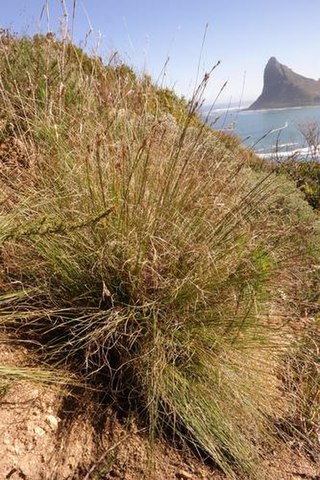
Schoenus arenicola is a species of sedge endemic to the south-west coast of South Africa.

Schoenus pictus is a species of sedge endemic to the Western Cape Province of South Africa. It is a species usually found on mountain slopes.

Schoenus megacarpus is a species of sedge endemic to the south-central region of South Africa.

Schoenus filiculmis is a species of sedge endemic to the western mountains of the Western Cape and Northern Cape Provinces of South Africa.

Schoenus graminifolius is a species of sedge endemic to the Cape Peninsula of South Africa.

Schoenus ligulatus is a species of sedge endemic to the western regions of the Western Cape Province of South Africa.

Schoenus crassus is a species of sedge endemic to south-western South Africa.

Schoenus riparius is a species of sedge endemic to the Cape Peninsula of South Africa.

Schoenus dregeanus is a species of sedge endemic to mountainous locations in south-western South Africa.

Schoenus adnatus is a species of sedge endemic to mountainous locations in southern regions of South Africa.

Schoenus complanatus is a species of sedge endemic to the western mountains of the Western Cape Province of South Africa.

Schoenus quadrangularis is a species of sedge endemic to mountainous of southern South Africa.

Schoenus schonlandii is a species of sedge endemic to locations near the southern coast of South Africa.

Schoenus gracillimus is a species of sedge endemic to the Western Cape Province of South Africa.

Schoenus lucidus is a species of sedge endemic to the western mountains of the Western Cape Province of South Africa.

Schoenus brunnescens is a species of sedge endemic to the Western Cape Province of South Africa.

Schoenus inconspicuus is a species of sedge endemic to south-western areas of the Western Cape Province of South Africa.

Schoenus crinitus is a species of sedge endemic to the Worcester region of the Western Cape Province of South Africa.

Schoenus rigidus is a species of sedge endemic to locations near central regions of the southern coast of South Africa.

Schoenus selinae is a species of sedge endemic to the Western Cape Province and western areas of the Eastern Cape Province of South Africa.


























